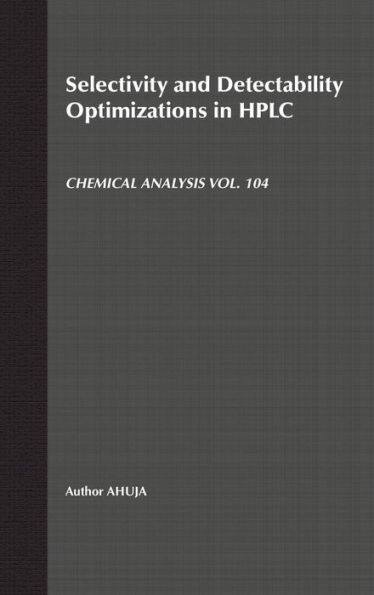Selectivity and Detectability Optimizations in HPLC
High Performance Liquid Chromatography Edited by Phyllis Brown and Richard Hartwick This contributed volume is designed to consolidate the basic theories of chromatography along with the more exciting developments in the field. This monograph addresses some questions that concern researchers in separation science, including: what is the current state of the art in liquid chromatography; has the development of liquid chromatography plateaued; if so, what new methods will take its place or complement it; and if not, where will the new frontiers be and what direction will liquid chromatography take? 1989 (0 471-84506-X) 688 pp. Quantitative Structure-Chromatographic Retention Relationships R. Kaliszan Written by a pioneer in the field, this book extends and updates research on quantitative structure retention relationships by consolidating and critically reviewing the extensive literature on the subject, while also providing the basic theoretical and practical information required in all investigations involving chromatography, analytical chemistry, biochemistry, and pharmaceutical research. Among the topics covered are the nature of chromatographic interactions, molecular interpretation of distribution processes in chromatography, topological indices as retention descriptors, and multiparameter structure-chromatographic retention relationships. 1987 (0 471-85983-4) 303 pp. Detectors for Liquid Chromatography Edited by Edward S. Yeung With its singular coverage of this fast-growing field, Detectors for Liquid Chromatography presents the state of the art in this subject area. It offers a comprehensive examination of the basic principles behind the detector response, instrumentation, and selected applications for comparison and evaluation of potential. Specifically, topics given in-depth coverage include polarimetric, indirect absorbance, refractive index detectors, absorption detectors for HPLC, FTIR and fluorometric detection, detection based on electrical and electromechanical measurements, and mass spectroscopy as an on-line detector for HPLC. 1986 (0 471-82169-1) 366 pp.
1147633862
Selectivity and Detectability Optimizations in HPLC
High Performance Liquid Chromatography Edited by Phyllis Brown and Richard Hartwick This contributed volume is designed to consolidate the basic theories of chromatography along with the more exciting developments in the field. This monograph addresses some questions that concern researchers in separation science, including: what is the current state of the art in liquid chromatography; has the development of liquid chromatography plateaued; if so, what new methods will take its place or complement it; and if not, where will the new frontiers be and what direction will liquid chromatography take? 1989 (0 471-84506-X) 688 pp. Quantitative Structure-Chromatographic Retention Relationships R. Kaliszan Written by a pioneer in the field, this book extends and updates research on quantitative structure retention relationships by consolidating and critically reviewing the extensive literature on the subject, while also providing the basic theoretical and practical information required in all investigations involving chromatography, analytical chemistry, biochemistry, and pharmaceutical research. Among the topics covered are the nature of chromatographic interactions, molecular interpretation of distribution processes in chromatography, topological indices as retention descriptors, and multiparameter structure-chromatographic retention relationships. 1987 (0 471-85983-4) 303 pp. Detectors for Liquid Chromatography Edited by Edward S. Yeung With its singular coverage of this fast-growing field, Detectors for Liquid Chromatography presents the state of the art in this subject area. It offers a comprehensive examination of the basic principles behind the detector response, instrumentation, and selected applications for comparison and evaluation of potential. Specifically, topics given in-depth coverage include polarimetric, indirect absorbance, refractive index detectors, absorption detectors for HPLC, FTIR and fluorometric detection, detection based on electrical and electromechanical measurements, and mass spectroscopy as an on-line detector for HPLC. 1986 (0 471-82169-1) 366 pp.
467.95
In Stock
5
1

Selectivity and Detectability Optimizations in HPLC
631
Selectivity and Detectability Optimizations in HPLC
631Hardcover
$467.95
467.95
In Stock

Product Details
| ISBN-13: | 9780471626459 |
|---|---|
| Publisher: | Wiley |
| Publication date: | 06/06/1989 |
| Series: | Chemical Analysis: A Series of Monographs on Analytical Chemistry and Its Applications , #140 |
| Pages: | 631 |
| Product dimensions: | 6.22(w) x 9.41(h) x 1.50(d) |
About the Author
From the B&N Reads Blog
